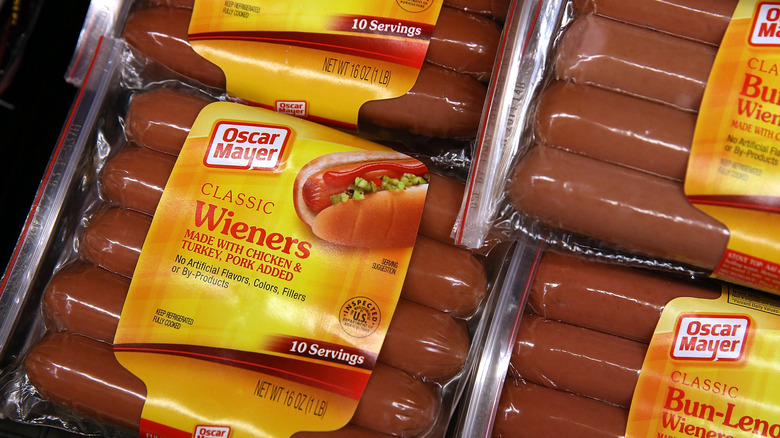Debunking The 10 Most Outrageous Hot Dog Myths
Is there anyone who doesn't love a good hot dog now and again? These beloved, iconic sausages have been a staple of American cuisine for generations. Yet, amid the sizzle of summer barbecues and the cheers at ballgames, there's an abundance of rumors and misinformation about what really makes a hot dog a hot dog. Hot dogs have endured their fair share of myths, from speculations of mystery meat to health concerns and even claims of wormy surprises. Unfortunately, some of these misconceptions can discourage people from eating hot dogs for fear of ingesting mystery meat, leftover organs, or plastic.
But fear not – in this article, we're going to peel back the bun and tackle the wildest hot dog myths head-on so you can better understand exactly what's in your hot dog and why there's a frank for just about everybody. From the fascinating history of the All-American sausage to your biggest food safety concerns, join us on a journey to uncover the truth about everyone's favorite ballpark snack.
1. Myth: Hot dogs are made from mystery meat
There's a longstanding misconception that we don't really know what's in our favorite hot dogs. However, manufacturers are required by law to list all the ingredients used in their products on the packaging. This includes not only the primary meat source but also any additives, preservatives, or flavorings that may be included. This transparency ensures that consumers have access to clear information about what goes into their hot dogs.
But what kinds of meat are they made of? Hot dogs are usually made from a combination of well-defined meat sources such as beef, pork, turkey, and chicken. The specific type of meat used is typically mentioned on the packaging. Consumers can choose hot dogs made from their preferred meat source. While it's true that hot dogs may contain meat trimmings and by-products, these are not mystery meat. Trimmings and byproducts are parts of the animal that are perfectly edible and safe when properly processed. They can include things like hearts, liver, and other organ meats. Using these parts helps reduce food waste and make manufacturing more sustainable.
The United States Department of Agriculture, or USDA, is responsible for regulating the production of meat products, including hot dogs. They set and enforce standards, including regular testing for pathogens and contaminants, to ensure that the hot dogs are safe for consumption. Any hot dogs found to be below these set and established quality standards will not be allowed to reach the market.
2. Myth: Hot dogs are strictly American inventions
While it's true that hot dogs are considered a classic American food, their story actually begins in Germany, where sausages have been a part of the culinary tradition for centuries. In particular, two German sausages are credited as being the original root of hot dogs: The frankfurter and the wienerwurst. The frankfurter originated in Frankfurt, Germany, and was made from pork. The wienerwurst, or wiener, was a sausage that hailed from Vienna, Austria, and was made primarily from beef. The term wiener is derived from wiener würstchen, which means Viennese sausage.
These sausages eventually made their way to the United States through German immigrants in the 19th century. These immigrants brought their sausage-making traditions with them, including recipes for frankfurters and wieners. In the 1860s, German immigrant Charles Feltman began selling sausages in rolls at Coney Island, New York. He sold these sausages in a roll as a convenient, handheld street food and is credited as the creator of the modern-day hot dog.
These long, thin sausages served in buns became known as dachshund sausages due to their resemblance to the dachshund dog, which may be the root of the term hot dog. We don't know who first coined the name hot dog, but we know that the term was being used as early as the 1890s at Yale, either as a reference to the dog breed or a joking remark about the possible ingredients in the sausage.
3. Myth: Hot dogs are a great food for young kids
Hot dogs can be a choking hazard for babies, toddlers, and very young children, especially those not yet used to eating solid foods. In fact, according to Johns Hopkins Medicine, hot dogs are among the foods most frequently associated with choking incidents in children. This is because hot dogs are springy, slick, and cylindrical, so they can easily become lodged in a child's throat or airway. However, the risk associated with hot dogs can be significantly reduced through proper preparation and vigilant supervision.
One safety measure is to cut hot dogs lengthwise into quarters or small pieces before serving them to young children to reduce the risk of choking, as recommended by Solid Starts. Always closely supervise young children while they are eating and follow a safe progression when introducing solid foods to infants and toddlers. Start with age-appropriate foods that are easy to swallow, and as a child grows and develops the ability to chew and swallow more effectively, you can gradually introduce foods like hot dogs. As children age, teach them safe eating habits, such as chewing food thoroughly and not rushing through meals.
Don't let all this worry you too much, however – while hot dogs can pose a choking hazard to babies, toddlers, and very young children, that doesn't mean that they are inherently unsafe, as long as you follow Johns Hopkins Medicine's recommended guidelines for introducing solid foods and promoting safe eating habits to ensure the well-being of young children.
4. Myth: Hot dogs are just for grilling and picnics
It's true that we often only think of hot dogs as something to serve at barbecues and baseball games. There are actually countless ways to prepare hot dogs. Apart from more traditional American-style hot dog dishes, they've also been adapted and incorporated into the cuisines of various cultures around the world. For example, in Vancouver, Canada, a Japanese-style hot dog chain called Japadog features hot dogs with toppings like teriyaki sauce and Japanese mayonnaise.
Hot dogs can be prepared using various cooking methods, not just grilling. Some common methods include boiling, frying, steaming, microwaving, or even baking. Each method imparts a slightly different flavor and texture to the hot dog, which is suitable for a range of different recipes like chili dogs, hot dog casseroles, hot dog stir-fries, or hot dog and vegetable skewers. Some restaurants even offer gourmet hot dogs with inventive toppings, condiments, vegetables, sauces, and cheeses.
And it's not just regular meat-based hot dogs that are getting a gourmet makeover. In recent years, vegetarian and vegan hot dogs have gained popularity, offering plant-based alternatives for those who prefer not to consume meat. These options are often topped with plant-based and vegan toppings like grilled vegetables, pad Thai, greens and sprouts, and even fruits like apples.
5. Myth: Hot dogs are full of additives and unhealthy fillers
Hot dogs have somewhat of a reputation as an unhealthy food that's full of low-quality ingredients, and there's a widespread perception that all hot dogs are full of unhealthy preservatives and artificial additives. While it's true that hot dogs are processed meat that does include preservatives, the composition of hot dogs can vary significantly depending on the brand and type you choose. Many reputable and higher-quality hot dog brands prioritize using real meat like 100% beef, quality ingredients, and minimal additives. So, if you're looking for a more natural product, you have options.
If you want to make an informed choice while shopping for healthier hot dogs, make sure to thoroughly check the product labels. The ingredient lists on the packaging will help you avoid hot dogs with too many additives. The shorter the ingredients list, the less change or artificial fillers. Look for hot dogs that match your dietary preferences and requirements, whether choosing a product without fillers or one free of specific additives. You may want to also look for organic hot dogs and those that advertise all-natural ingredients.
6. Myth: Hot dogs are not suitable for vegetarians
If you practice a vegan or vegetarian lifestyle, there's no reason that you should have to go without hot dogs in your life. Sure, they may not be the same thing as the original, but they can still be the star of your next cookout while fitting into a plant-based lifestyle. Hot dogs are available in a wide range of vegetarian and vegan versions, providing a tasty and cruelty-free option for individuals who do not consume meat or animal products. Vegetarian hot dogs are made from plant-based ingredients such as soy protein, tofu, tempeh, or a combination of vegetables. They're also formulated to mimic the taste and texture of traditional meat-based hot dogs for a satisfying alternative.
Vegan hot dogs take vegetarian hot dogs a step further by excluding all animal-derived ingredients, including dairy and eggs. They use ingredients like pea protein, vital wheat gluten, or legumes to create a meat-like texture and flavor. Vegetarian and vegan hot dogs provide a cruelty-free option for individuals who are concerned about animal welfare and ethical food choices. These hot dogs do not involve the use of animal slaughter or exploitation. You can also enjoy a homemade version of a vegan hot dog by using a carrot instead of a sausage. Vegetarian and vegan hot dogs, like traditional hot dogs, come in various flavors and styles. Some are spicy, smokey, or offer different seasonings to cater to diverse tastes.
7. Myth: Hot dogs aren't suitable for those with dietary restrictions
Think you can't enjoy a hot dog because of your specific dietary needs? You might be surprised to learn how many varieties and types of hot dogs are out there. Hot dogs come in a wide range of options and ingredients to accommodate all kinds of dietary restrictions and preferences. There are kosher, halal, gluten-free, and other specialized hot dog options for those with dietary restrictions.
If you keep Kosher or Halal dietary practices, you can still enjoy a hot dog on occasion. Kosher hot dogs are made without pork, and usually contain beef or poultry, and follow specific processing standards. Halal hot dogs are prepared in accordance with Islamic dietary laws, are made from halal-certified meats, and do not contain pork or other prohibited ingredients.
If you have celiac disease or gluten sensitivity, you may be happy to learn that most hot dogs are gluten-free by default; just make sure to double-check the ingredients. You may also want to seek out brands that produce organic hot dogs made with natural ingredients and fewer additives and preservatives. Some hot dog brands also produce low-sodium or reduced-sodium versions for people who need to limit their salt intake, such as those with hypertension or heart conditions, as recommended by Heart.
8. Myth: Hot dogs cause cancer
Here's a myth with a slight ring of truth to it — according to the American Institute for Cancer Research, eating 3.5 ounces of processed meat per day can increase your risk of colon cancer by up to 36%, and the World Health Organization has classified processed meat as a Group 1 carcinogen. However, it's not quite that simple. The concern about cancer primarily revolves around the consumption of processed meats in general, not just hot dogs. Processed meats are meats that have undergone various preservation methods, such as smoking, curing, or adding preservatives. That includes bacon, sausage, ham, and hot dogs.
Still, that doesn't mean you can never have hot dogs again. Moderation and overall dietary habits play a significant role in how high your cancer risk may be. Consuming processed meats occasionally as part of a balanced diet is not likely to have a substantial impact on cancer risk. The habitual and excessive consumption of these meats may pose a potential risk.
Also, not all hot dogs are created equal. Some brands may use higher-quality ingredients and fewer additives than others. Reading product labels and choosing hot dogs with fewer preservatives and additives can be healthier. For individuals concerned about the potential health risks associated with processed meats, there are alternative options available, like vegetarian or vegan hot dogs that are plant-based and free of animal byproducts.
9. Myth: Hot dog casings are made from plastic
There's a common misunderstanding concerning the casings that contain hot dog meat. All hot dogs are made by packing meat into casings, just like any other sausage. But not all casings are created equal. Hot dog casings are typically not made from plastic; instead, they can be categorized into two main types: natural and artificial casings.
The main difference between the two is that natural casings are made from animal products, specifically the intestines of animals, primarily pigs, sheep, or cattle, while edible artificial casings are usually made from cellulose or collagen.
That doesn't mean that you're eating plastic when you grill up a hot dog; the vast majority of hot dogs are caseless and are made by pre-cooking the meat in an artificial casing that is removed before packaging. If your hot dogs do have an artificial casing that has not been removed, the labeling should include instructions to remove the casing before consumption. However, hot dogs with inedible artificial casings included in the packaging are very rare.
10. Myth: Hot dogs are a leading cause of food poisoning
This myth has a grain of truth to it, but it may not be for the reason that you think. Like any food, hot dogs can pose a risk if they are not handled or prepared correctly. While hot dogs are not a leading cause of food poisoning, foodborne illnesses are often linked to various factors, including mishandling of food during preparation or storage, contamination from other sources, or consuming undercooked hot dogs, according to the Partnership for Food Safety Education.
The key to safe consumption of hot dogs is proper food handling and cooking practices. Hot dogs should be stored at the appropriate temperature (refrigerated) and consumed before their expiration date to prevent the growth of harmful bacteria. Hot dogs are usually pre-cooked during manufacturing, but it's essential to heat them adequately before consumption. This step helps kill any potential pathogens that may be present. According to food safety guidelines, hot dogs should be heated to an internal temperature of at least 140 degrees Fahrenheit to ensure they are safe to eat. This is typically achieved by grilling, boiling, or microwaving.
Hot dogs only present a food poisoning risk when handled, stored, and cooked properly. Like any food product, the risk of foodborne illness is primarily associated with improper food handling and preparation practices. Following recommended food safety guidelines and cooking hot dogs to the appropriate temperature significantly reduces the risk of foodborne illnesses associated with hot dogs.










